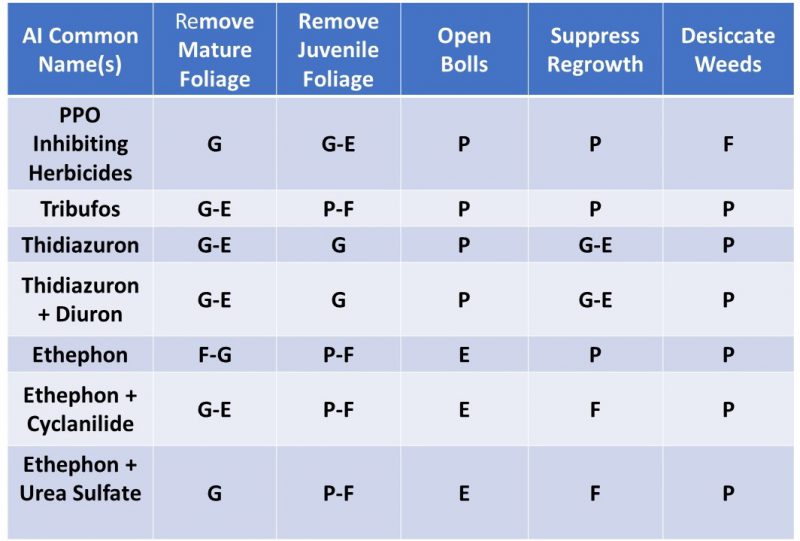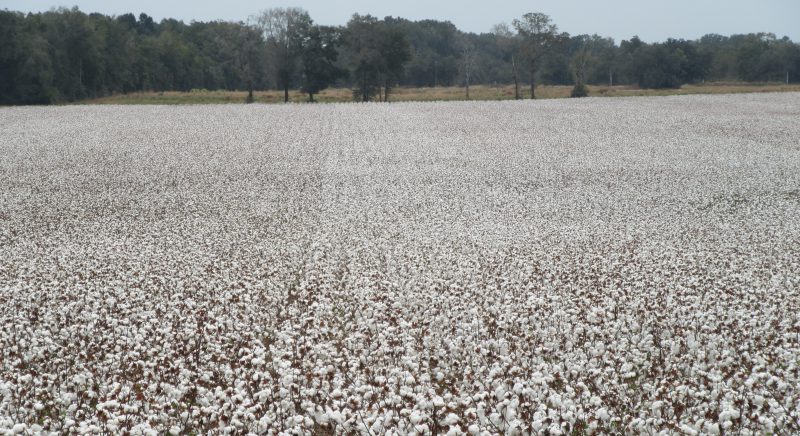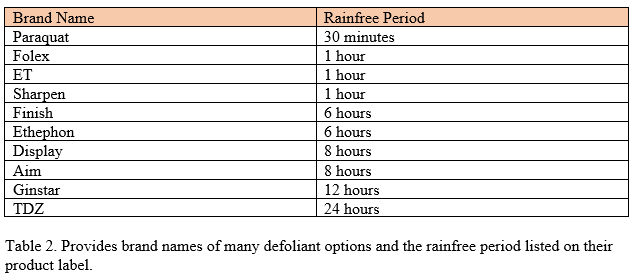Ethan Carter, Regional Crop IPM Agent, David Wright, UF/IFAS Agronomist, & Mark Mauldin, Washington County Extension Ag Agent
It’s that time of year again, cotton defoliation is hot on the heels of peanut harvest. Many farmers are in the middle of digging peanuts, and are starting to pick peanuts, while also setting their sites on cotton defoliation. From first bloom to open boll is typically about 60 days, and harvest generally occurs 25-30 days later. Often, growers wait too late to defoliate, as the field is ready earlier than typically expected. There are two primary techniques used to effectively gauge field readiness when it comes to defoliation. When a cotton field has reached either of the thresholds listed below, it is time to defoliate the field.
Plants have 60-70% open bolls
or
Plants have 4 or fewer nodes above the highest cracked boll (NACB)
A sharp knife is a less scientific but a tried and true way to determine the maturity of individual bolls. Mature bolls are difficult to cut, have brown seed coats, and fibers that will string when you attempt to cut. If you can cut through the boll with a knife it is not mature. Using this technique to evaluate boll maturity can have value for tracking the progression of the crop, but the final defoliation decision should be made based on on of the two criteria listed above.
There are several active ingredients that can be effectively used as harvest aids for cotton. The different Active Ingredients (AI) all have varying strengths and weaknesses in relation to the individual aspects of effective defoliation. As such, two or more active ingredients are frequently used together. For example Ethephon, Thidiazuron, and Tribufos (Prep, Dropp, and Folex) are commonly all used together. Table 1. outlines the efficacy of several active ingredients for specific aspects of defoliation.

Table 1. Performance rating of harvest aids by function (P=poor, F=fair, G=good, E=excellent
Adapted from: https://edis.ifas.ufl.edu/pdf/AG/AG18800.pdf
Brand names associated with the active ingredients shown in Table 1. are listed below:
PPO Inhibiting Herbicides
- Aim (carfentrazon)
- ET- (Pyrafluefen ethyl)
- Resource (flumiclorac)
- Blizzard (flutiacet-methyl)
Tribufos
- Def 6 Emulsifiable
- Folex 6 EC
Thidiazuron
- Daze 4SC
- Frefall SC
- Klean-Pik 500 SC
- Takedown
Thidiazuron + Diuron
- Ginstar
- Adios
- Cutout
- Redi-Pick
Ethephon
- Prep
- Boll Buster
- Super Boll,
- SetUp 6 SL,
- many others
Ethephon + Cyclanilide
- Finish 6 Pro
Ethephon + Urea Sulfate
- FirstPick
–
Temperature plays an important role in defoliation and can drastically impact the fields defoliation time. During cooler weather, it is necessary to increase defoliant rates, and it is not uncommon for a 10–15-day window from date of defoliation to picking. Read the publication 2020 Cotton Defoliation and Harvest Aid Guide for specific product and rate recommendations based on temperatures at the time of defoliation.
–
General Notes about Cotton Defoliation
- Growers should be weary of using Paraquat, as plant leaves tend to stick/hang on to the plant which results in trash in the lint during picking.
- Waiting for frost to kill plants prior to harvest is not a good idea, once frosted, any unopened bolls will not open.
- High fertility fields are often the hardest to defoliate; this should be considered when selecting products and rates.
- Fields with dense canopies and high numbers of green bolls may require two harvest aid applications, with the first focused on defoliation and the second on boll opening.
- The rainfree periods for harvest aids vary greatly. If rain is in the forecast, be sure to be sure to consider the rainfree period of all products used, as illustrated in the table below.
Specific product options and rates are included in the UGA Pest Management Handbook, or by using the following link:
UGA Cotton Defoliation Guide
–
For specific questions or more information, contact your local extension office.
- Provisional Nitrogen Fertilization Recommendation for Florida Cotton for the 2025 Season - June 20, 2025
- NFREC-Quincy Row Crop Field Day – July 21 - June 20, 2025
- NFREC-Marianna Peanut Field Day – August 14 - June 20, 2025


